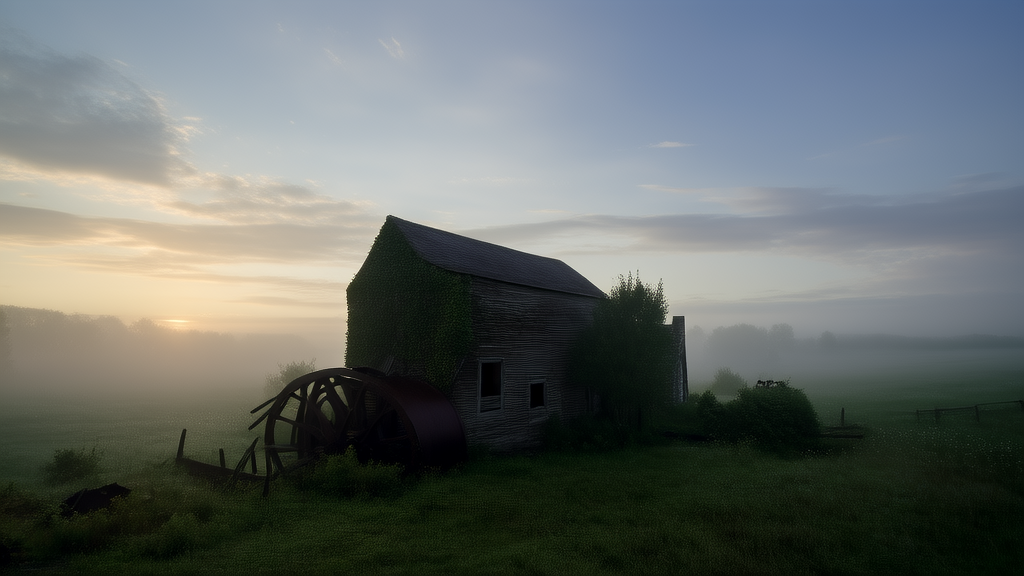🔮 Weird Tales & Urban Legends
The Forgotten Mill of Elmsworth and the Secrets Beneath the Fog

Every town has its secrets, and the quiet village of Elmsworth was no different. Nestled in a valley where the fog clung to the ground like a living thing, it was the kind of place where time seemed to slow down. Locals spoke in hushed tones about the old mill on the edge of the woods, a crumbling structure that had stood for over two centuries. No one knew exactly when it had stopped operating, but it had long since been abandoned, its windows shattered, its roof sagging under the weight of moss and ivy.
The unsolved mystery of Elmsworth revolved around the disappearance of the miller's daughter, Clara Voss. She vanished on the night of the autumn equinox, 1937, when she was just seventeen. Her father, Elias Voss, was found dead the next morning, slumped over his workbench, a single candle burning beside him. The police never found Clara, nor any sign of what had happened. The only clue was a piece of paper with her handwriting: "It’s not the end. It’s just the beginning."
For decades, the story remained a local legend, passed down in whispers and stories told around fireplaces. But in the early 2000s, a group of students from the nearby university decided to investigate. They were young, curious, and convinced they could uncover the truth. They spent weeks researching old records, interviewing elderly residents, and even visiting the mill at night, hoping to catch a glimpse of something unusual.
On the third night of their expedition, the group encountered a strange phenomenon. As they approached the mill, the air grew colder, and the trees around them seemed to sway without wind. A faint melody drifted through the silence, like a lullaby sung by an unseen voice. One of the students, a girl named Lila, claimed she heard her mother’s voice calling her name. She ran back toward the road, leaving the others behind.
The remaining three continued into the mill. Inside, the air was thick with dust and the scent of decay. The floor creaked beneath their feet as they climbed the rickety stairs. At the top, they found a small room filled with old tools and faded photographs. One of the pictures showed a young woman standing near the mill, her face half-hidden by shadow. It was Clara.
As they examined the room, the temperature dropped sharply. The candles they had brought flickered violently, then went out. In the darkness, they heard footsteps—slow, deliberate, and close. Someone was there with them. They ran, stumbling down the stairs, barely making it out before the door slammed shut behind them. When they reached the car, they noticed that the rear window was covered in frost, despite the warm weather.
After that night, none of them spoke of the experience again. Lila disappeared shortly after, leaving behind only a note: "I had to go." The other two returned to the university, but they changed. They became reclusive, avoided talking about the trip, and refused to return to Elmsworth.
Years passed, and the mystery faded into obscurity once more. But every year, on the night of the autumn equinox, the fog would gather around the mill, thick and impenetrable. Locals would hear the same melody drifting through the woods, and some claimed to see a figure standing near the broken windows, watching.
One day, a new resident moved into the village—a man named Thomas Grey, a writer seeking inspiration. He became fascinated by the legend of Clara Voss and the mill. He spent months studying the history, visiting the site, and speaking with the villagers. He even tried to document the strange occurrences, but no one believed him.
One night, he went to the mill alone. The air was still, the sky clear. He stepped inside, torch in hand, and walked through the familiar corridors. In the same room where the students had found the photograph, he discovered a journal hidden beneath the floorboards. It belonged to Clara.
She wrote of a secret ritual performed by her family, a way to commune with the unseen. She described how the mill was built not just as a place of work, but as a gateway. She believed that on certain nights, the veil between worlds was thin, and that something watched from the other side.
The final entry was dated the night she disappeared: "They are waiting. I have seen them. They do not want me to leave. But I must. I am not ready. I cannot stay."
Thomas left the journal behind, but he never returned to the village. His last letter, sent to a friend, read: "I think I understand now. The mill is not empty. It is alive. And it remembers."
No one has ever seen him again. But on the night of the autumn equinox, if you stand near the mill and listen closely, you might hear a whisper in the wind. A voice, soft and sorrowful, saying, "It’s not the end. It’s just the beginning."
发布于 en
🔗
相关站点
- AI Blog — AI 趋势与技术新闻